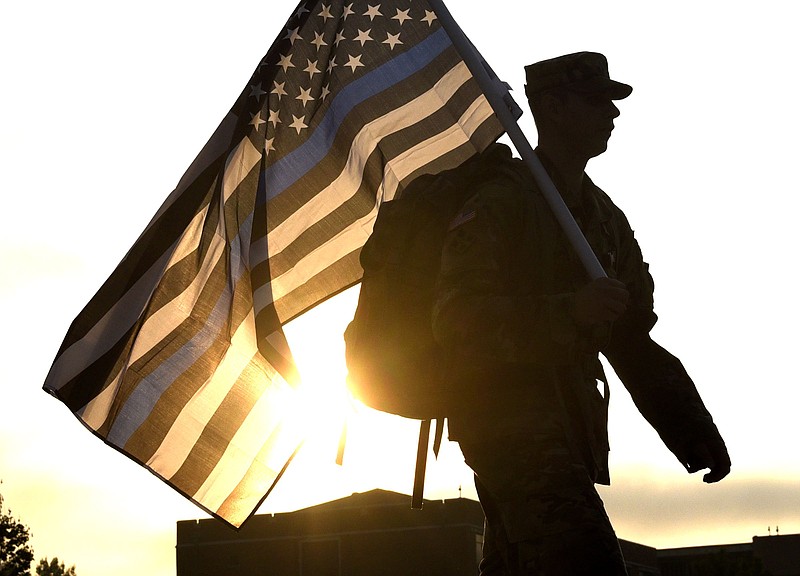For Americans, 9/11 will always recall Sept. 11, 2001, the catastrophic day of terrorist attacks on New York City, the Pentagon, and passengers on United Airlines Flight 93. For residents of Western and Central Europe, where the day always precedes the month, 9/11 commemorates the date that the Berlin Wall was breached 30 years ago on 9 November 1989. Both dates had far-reaching consequences.
Following the surrender of Germany in 1945, Allies divided the nation into four zones controlled by French, British, American and Russian forces. Berlin, in the Russian sector, was similarly divided. In March 1948, the three Western allies merged their occupation zones and launched a deutsche mark currency.
Russia abruptly blocked all road, rail and canal access to Berlin on June 24, 1948, touching off the first major crisis of the Cold War. Russian leaders believed Western allies would simply abandon Berlin. Two days later, the U.S. and Great Britain launched the "Berlin Airlift." All food, fuel and other necessary supplies had to be transported by air to the people of West Berlin. At the peak of the airlift, an airplane took off or landed every 30 seconds from three airfields in West Berlin - almost 300,000 flights in all. The blockade ended on May 12, 1949. Airlift flights continued for several additional weeks. Twenty-five U.S. and UK aircraft crashed during the airlift.
West Germany officially became the Federal Republic of Germany in May 1949 and would join the North Atlantic Treaty Organization (NATO). In October 1949, Russian-controlled East Germany morphed into the German Democratic Republic (GDR), which became a satellite state of the Soviet Union.
On Aug. 13, 1961, East Germany began construction of the infamous Berlin Wall. Initial barbed wire barricades were followed by an 87-mile wall of concrete blocks that encircled West Berlin. Guard towers, beds of spikes and anti-vehicle barriers completed the barrier. Walled off West Berlin represented a powder keg, a potential starting point of armed conflict between NATO and Russia and its satellites. Movement to and from West Berlin was limited to six checkpoints. Attempts to climb over or crash the wall from East Berlin were met with deadline gunfire.
President Kennedy visited West Berlin on June 26, 1963, and spoke to a massive crowd from the steps of the city hall. His speech concluded, "Today in the world of freedom, the proudest boast is, 'Ich bin ein Berliner (I am a Berliner)!'" Linguists have contended that Kennedy's words actually translate as "I am a jelly donut,' but the assembled crowd understood the sentiment of his words.
Tensions persisted along the barrier. During a speech in West Berlin on June 12, 1987, President Reagan uttered the challenge: Mr. Gorbachev, tear down this wall."
A chain reaction of revolts against Communist domination in Eastern Europe reached the GDR in the autumn of 1989. The head of the GDR Communist Party reluctantly announced on Nov. 9 that East Germans were free to cross into West Berlin. Thousands of East Germans gathered at the six checkpoints along the wall. At 10:45 p.m. guards opened the gates. Subsequently, the wall was attacked from both sides with chisels and sledgehammers and soon would be demolished by heavy equipment. The most visible symbol of the Cold War had vanished.
Reunification of East and West Germany occurred on Oct. 3, 1990.
Long in the planning stage, the European Union (EU) officially began on Nov. 1, 1993. Twenty-eight nations, including several previously under Russian control, currently belong to the EU.
A new era of peace, prosperity and economic and political cooperation seemed permanently installed in Central and Western Europe. In recent years cracks in this unity have appeared. The UK is soon likely to withdraw from the EU. Hungary's "soft dictatorship" has undermined democracy in that nation. For the moment, the promise of Europe's 9/11 is holding.
"Post War: A History of Europe Since 1945" by Tony Just is a fine summary of these momentous events.
Contact Clif Cleaveland at ccleaveland@timesfreepress.com.
